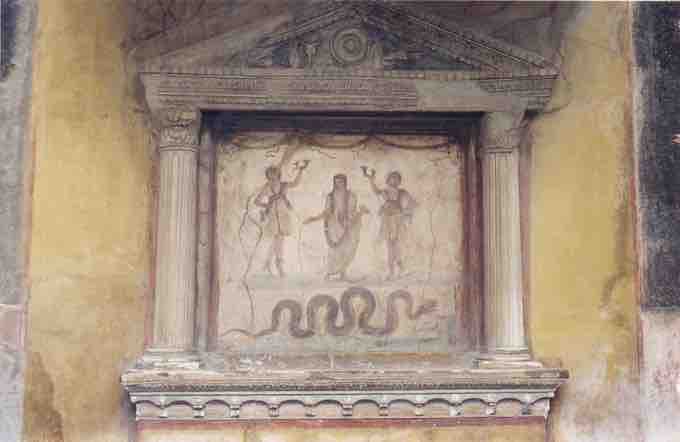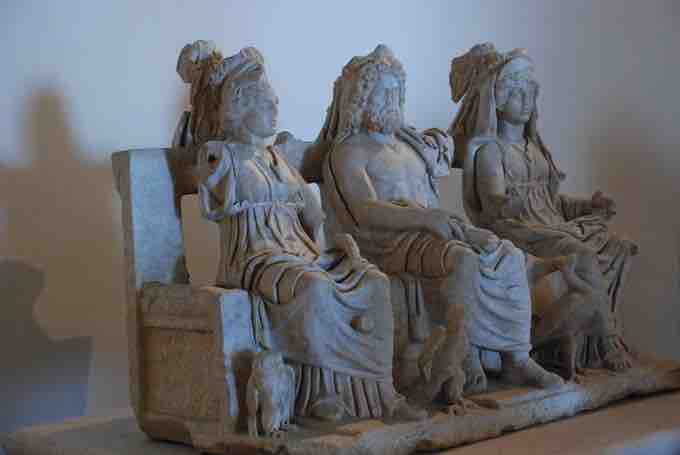Social Structure
Life in ancient Rome centered around the capital city with its fora, temples, theatres, baths, gymnasia, brothels, and other forms of culture and entertainment. Private housing ranged from elegant urban palaces and country villas for the social elites to crowded insulae (apartment buildings) for the majority of the population. The large urban population required an endless supply of food which was a complex logistical task. Area farms provided produce, while animal-derived products were considered luxuries. Aqueducts brought water to urban centers, and wine and oil were imported from Hispania (Spain and Portugal), Gaul (France and Belgium), and Africa. Highly efficient technology allowed for frequent commerce between the provinces. While the population within the city of Rome might have exceeded one million, most Romans lived in rural areas, each with an average population of 10,000 inhabitants.
Roman society consisted of patricians, equites (equestrians, or knights), plebeians, and slaves. All categories except slaves enjoyed the status of citizenship. In the beginning of the Roman republic, plebeians could neither intermarry with patricians or hold elite status, but this changed by the Late Republic, when the plebeian-born Octavian rose to elite status and eventually became the first emperor. Over time, legislation was passed to protect the lives and health of slaves. Although many prostitutes were slaves, for instance, the bill of sale for some slaves stipulated that they could not be used for commercial prostitution. Slaves could become freedmen--and thus citizens--if their owners freed them or if they purchased their freedom by paying their owners. Free-born women were considered citizens, although they could neither vote nor hold political office.
Within the household, the pater familias was the seat of authority, possessing power over his wife, other women who bore his sons, his children, his nephews, his slaves, and the freedmen to whom he granted freedom. His power extended to the point of disposing of his dependents and their good, as well as having them put to death if he chose. In private and public life, Romans were guided by the mos maiorum, an unwritten code from which the ancient Romans derived their social norms that affected all aspects of life in ancient Rome.
Roman family.
Relief of a Roman family with the child in the middle, the father on the left, and the mother on the right.
Government
Over the course of its history, Rome existed as a kingdom (hereditary monarchy), a republic (in which leaders were elected), and an empire (a kingdom encompassing a wider swath of territory). From the establishment of the city in 753 BCE to the fall of the empire in 476 CE, the Senate was a fixture in the political culture of Rome, although the power it exerted did not remain constant. During the days of the kingdom, it was little more than an advisory council to the king. Over the course of the Republic, the Senate reached the height of its power, with old-age becoming a symbol of prestige, as only elders could serve as senators. However the late Republic witnessed the beginning of its decline. After Augustus ended the Republic to form the Empire, the Senate lost much of its power, and with the reforms of Diocletian in the third century CE, it became irrelevant.
As Rome grew as a global power, its government was subdivided into colonial and municipal levels. Colonies were modeled closely on the Roman constitution, with roles being defined for magistrates, council, and assemblies. Colonists enjoyed full Roman citizenship and were thus extensions of Rome itself. The second most prestigious class of cities was the municipium (a town or city). Municipia were originally communities of non-citizens among Rome's Italic allies. Later,Roman citizenship was awarded to all Italy, with the result that a municipium was effectively now a community of citizens. The category was also used in the provinces to describe cities that used Roman law but were not colonies.
The Roman Senate.
Nineteenth-century fresco in the Palazzo Madama in Rome, depicting a sitting of the Roman Senate in which the senator Cicero attacks the senator Catiline.
Religion
The Roman people considered themselves to be very religious. Religious beliefs and practices helped establish stability and social order among the Romans during the reign of Romulus and the period of the legendary kings. Some of the highest religious offices, such as the Pontifex Maximus, was a sought after political position, which eventually became one of the titles of the emperor. Women who became Vestal Virgins, who served the goddess of the hearth Vesta, received a high degree of autonomy within the state, receiving rights other women would never receive.
The Roman pantheon corresponded to the Etruscan and Greek deities. Jupiter was considered the most powerful and important of all the Gods. In nearly every Roman city, a central temple known as the Capitolia that was dedicated to the supreme triad of deities: Jupiter, Juno, and Minerva (Zeus, Hera, and Athena). Small household gods, known as Lares, were also popular. Each family claimed their own set of personal gods and laraium, or shines to the Lares, are found not only in houses but also at street corners, on roads, or for a city neighborhood.

Lararium
A lararium from the House of the Vettii. Fresco and stucco. Pompeii, Italy.

Capitoline Triad
Juno, Jupiter, and Minerva made up the Capitoline Triad. They often shared a temple, known as the Capitolia, in the center of a Roman city. Sanctuary of Fortuna Primigenia, Palestrina, Italy.
Roman religious practice often centered around prayers, vows, oaths, and sacrifice. Many Romans looked to the gods for protection and would complete a promise sacrifice or offering as thanks when their wishes were fulfilled. The Romans were not exclusive in the religious practices and easily participated in numerous rituals for different gods. Furthermore, the Romans readily absorbed foreign gods and cults into their pantheon.
With the rise of imperial rule, the emperors were considered gods, and temples were built to many emperors upon their death. Their family members could also be deified. Sites of imperial cult worshiped the dead and deified emperors along with the living consort, and the household gods of the emperor's family were also incorporated into Roman worship.